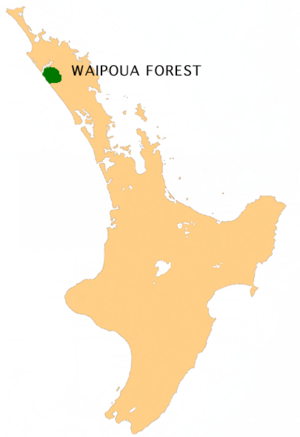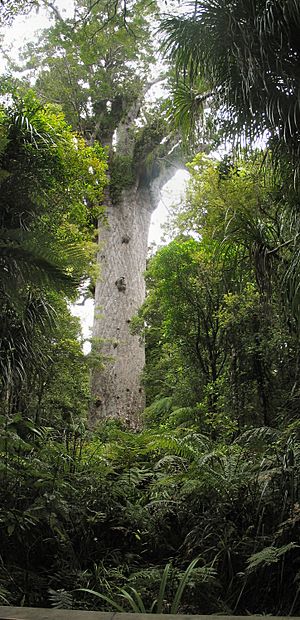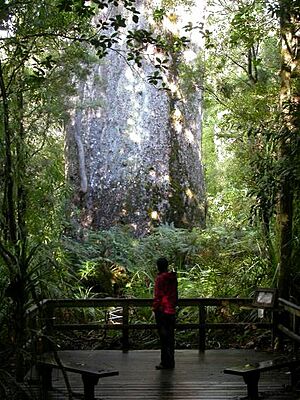Waipoua Forest facts for kids
The Waipoua Forest is a special forest located on the west coast of the Northland Region in New Zealand's North Island. It's famous for protecting some of the best examples of ancient kauri trees left in New Zealand. This forest is home to two of the biggest living kauri trees in the world: Tāne Mahuta and Te Matua Ngahere.
The Waipoua Forest became a protected area, called a sanctuary, in 1952. A group of volunteers, the Waipoua Forest Trust, helps look after it. The forest is next to the Professor W.R. McGregor Reserve, which is about 350 hectares (865 acres) in size. This reserve is named after William Roy McGregor, who helped save the forest. In the 1940s, he and others worked hard to stop logging (cutting down trees) in the forest. Thanks to their efforts, it became a sanctuary.
Around 200,000 people visit Tāne Mahuta every year. This many visitors can sometimes cause problems for the forest's health. One big worry is the spread of kauri dieback disease, which harms kauri trees.
Contents
Amazing Trees and Wildlife in Waipoua Forest
The Waipoua, Warawara, and Puketi forests hold about three-quarters of all the mature kauri trees left in New Zealand. Waipoua Forest has the largest group of these incredible trees.
Meet the Giant Kauri Trees
The forest is home to Te Matua Ngahere, another famous kauri tree. It's the widest kauri tree in New Zealand and the second largest by how much wood it contains. Experts believe this tree is between 2,000 and 3,000 years old!
Protecting the Forest from Disease
Sadly, these ancient trees are in danger from a fungus called Phytophthora taxon Agathis. This fungus causes kauri dieback disease. The Waipoua Forest Trust has asked the government to act quickly to find a way to cure this problem and protect the trees.
Animals Living in Waipoua Forest
Waipoua Forest is also a very important home for animals. It has the biggest group of North Island brown kiwi in the Northland area. You can also find the rare North Island kōkako bird living in the higher parts of the forest.
Fighting Forest Fires
On February 1, 2007, a forest fire started near Waipoua Forest. It began when someone was cooking mussels on an open fire at a nearby beach. The fire burned through a pine tree farm next to the native forest. It also destroyed important wetland plants. The fire came very close, within 3 kilometers (1.9 miles), of the famous Tāne Mahuta tree.
Local firefighters and conservation volunteers worked hard to stop the fire. They used helicopters and created fire breaks (areas cleared of trees to stop the fire from spreading). Millions of dollars worth of pine trees were lost, and many endangered birds died, including about 20 North Island brown kiwi. In total, the fire burned over 2 square kilometers (0.77 square miles) of plants.
History of Waipoua Forest Protection
The Waipoua Forest was bought from Māori leaders, Tiopira Kinaka (Te Roroa) and Parore Te Awha (Te Kuihi), in 1876. It was part of a larger land deal and cost a little over £2,000. At that time, the forest covered about 80 square kilometers (31 square miles).
Becoming a State Forest Reserve
In 1885, the Waipoua Forest became a State Forest Reserve under a special law called the State Forests Act. About 90 square kilometers (35 square miles) were set aside. One reason the forest wasn't destroyed earlier was its remote location. It was also very difficult to remove the timber (wood) from such a dense forest. Another reason was that, like the Warawara Forest to the North, Waipoua received plenty of rain. This meant that fires started by Māori and European settlers didn't burn through it, unlike other forests in the 1870s and 1880s.
Calls for National Protection
By 1907, Waipoua Forest, Warawara Forest, and a few other small areas were the only untouched kauri forests still owned by the state. In 1913, a Royal Commission on Forestry suggested that a special area of 0.8 square kilometers (0.31 square miles) of Waipoua Forest and all of the 50 square kilometers (19 square miles) of Warawara Forest should become national kauri forests for all New Zealanders to enjoy. In 1926, a road was built through Waipoua Forest to help settlers living nearby.
The Fight to Save Waipoua
In the 1940s, people found out that the State Forest Service was cutting down kauri trees in Waipoua. In 1947, several groups, including the Whangarei Progressive Society and the Royal Forest and Bird Protection Society, gathered more than 43,000 signatures on a petition. This petition asked for Waipoua State Forest to become a national park managed by a special board, and for all logging to stop. The petition, made up of thirteen large books of signatures, was presented to parliament in a wheelbarrow! People hoped that 160 square kilometers (62 square miles) of Waipoua would be protected forever from human interference. More petitions followed. Finally, on July 2, 1952, an area of over 80 square kilometers (31 square miles) was officially made a forest sanctuary. The zoologist William Roy McGregor was a key person in this movement. He wrote an 80-page book with pictures that helped convince many people to support conservation.
In the late 1960s, despite earlier recommendations, the government started clear-felling (cutting down all trees) in the Warawara forest. This was stopped in 1972 after a large public outcry and a promise from the new Labor Government. In that short time, about one-fifth of the forest was cut down.
Waipoua Forest Trust: Guardians of the Forest
The Waipoua Forest Trust is a group of people from the community who work to protect the kauri forests in the Waipoua area. It was started in 1999. The Trust is a partnership between the Native Forests Restoration Trust and Te Roroa, who are the Māori guardians of Waipoua. Together, these groups help guide the Department of Conservation in managing the forest.
Protecting More Land
In March 2000, the New Zealand Minister of Internal Affairs, Mark Burton, helped launch the Millennium Kauri Forest. This was south of the Waipoua Forest. The Waipoua Forest Trust received a $1.4 million lottery grant and a gift of land. Most of this money was used to buy more land to protect the southern edges of the forest. The Trust also works with the Native Forests Restoration Trust, which manages the Professor McGregor Reserve. They have bought farmland north of the McGregor Reserve, helping to protect the southern part of the Waipoua area. Through a special agreement with the Queen Elizabeth II National Trust, the Trust also looks after about 16 hectares (40 acres) of the Marlborough Road forest, which is south of the main Waipoua reserve.
What the Trust Does
The Trust is working hard to save the last of the ancient kauri trees and help the wildlife in the park recover. They are actively replanting areas that were previously logged, turning them back into their original forest state. They are also working to set up a kiwi hatchery to help increase the number of kiwi birds. People can learn about their work through a photo display at the Kauri Museum in Matakohe. In 2007, the ASB Community Trust gave the Waipoua Forest Trust $810,000 to support their work.
Volunteers help by removing weeds from planted areas, maintaining the ground, collecting flax seeds, and checking for and getting rid of pests like rats and possums. By June 2007, the Trust had spent over NZ$4 million on protecting and restoring land. The Kaipara District council has supported the Trust in asking the Ministry for the Environment for money to replant areas with native plants. In November 2007, the Trust was very upset when the Department of Conservation decided to cut down a 600-year-old kauri tree for a road widening project.
In April 2009, Alex Nathan, who leads both Te Roroa Whatu Ora and the Waipoua Forest Trust, met with a leader from the Yakushima community in Japan. Yakushima also cares about protecting ancient giant trees. The two leaders started the "Family of Ancient Trees" project to raise awareness and encourage eco-tourism (travel that helps the environment). This agreement came after several visits and discussions between members of the Trust and other New Zealand groups with their Japanese partners. In May 2009, the Trust was one of the sponsors of the Waipoua Forest run, where many Japanese visitors took part.
Images for kids
See also
 In Spanish: Bosque de Waipoua para niños
In Spanish: Bosque de Waipoua para niños





